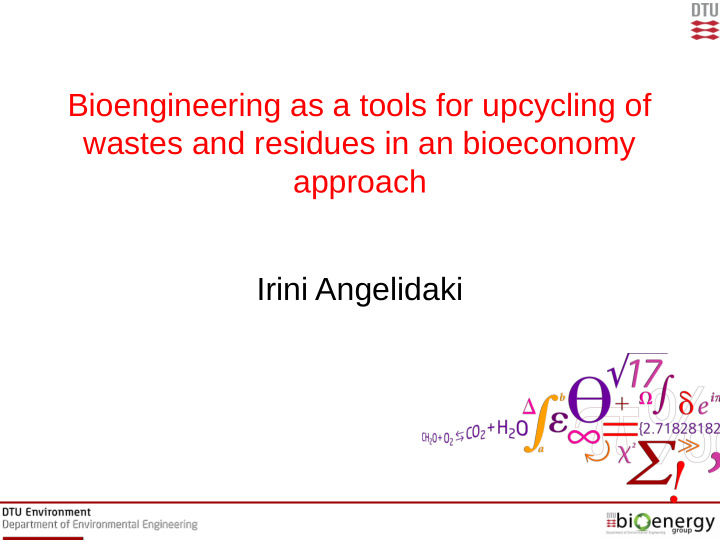



Bioengineering as a tools for upcycling of wastes and residues in an bioeconomy approach Irini Angelidaki
Sustainability?
The Vision - Bioeconomy
270.000 households sort biowaste from 2017
Urban biowaste - Copenhagen Source sorted household waste Organic waste from industries Biopulping technology
Biopulping technology Pulper Waste inlet Separator Buffer tank for pulping water Washing water buffer tank Dewatering unit Raw pulp buffer tank Biopulp Biopulp Bioenrgy group Biopulp storage tank
Valorizing urban bio-waste from Copenhagen 1: Single cell protein 2: BioSuccinic acid Biopulp 4: Biomethane 3: Lactic acid
1) Single Cell Protein (SCP)
Demand for edible protein • 100 g of edible protein per person per day • Protein mainly comes from plant protein (soya) • World agricultural soils are limited. • Other sources for protein? Microbial protein (SCP)?
Single cell Protein SCP refers to edible unicellular microorganisms which contain protein. Protein can be extracted from pure or mixed cultures of algae, yeasts, fungi or bacteria. The biomass produced can substitute protein rich foods. It is suitable for human consumption or as animal feeds.
Single cell Protein production CHP plants Electricity Heat Biogas Microbial protein Fuel Treatment Fermentatio n Cleaning and upgrading Home cooking fuel Biogas Digestate Bio-fertilizer Bio-fertilizer Dewatering & pasteurization
Digestate treatment for SCP production Centrifuge pasteurize system Liquid fraction used to cultivate SCP Digestate Extracted ammonium supplemented with trace elements used to cultivate SCP Electrochemical process
Yield and amino acid profile of SCP Y CH4, Centr. = 1.34 g/g CH 4 Y CH4, pure CH4 = 1.14 g/g CH 4 Y CH4, Elec. = 1.29 g/g CH 4 Y CH4, Biogas = 1.36 g/g CH 4 Y CH4, Upg.Biogas = 1.5 g/g CH 4
2) BioSuccinic Acid
BioSuccinic Acid – Platform Chemical 1,4-butanediol Spot price for SA Succindiamide ranges from 2.8 to 8.5 €/kg Food 1,4-Diaminobutane Application Industrial Succinonitrile Application Cosmetics Application Dibasic ester Others Pharmaceutical N-Methyl-2-pyrrolidone Application -Butyrolactone 2-Pyrrolidone Tetrahydrofuran
BioSuccinic Acid - The Technology Simultaneous biomethane and biosuccinic acid production Gas containing CH 4 ( 95 %(v/v)) Arabinose CH 4 Fructose, Fucose Galactose, Glucose Glycerol (Diesel production) Effluent containing succinic acid Feedstock Lactose Maltose, Mannitol, Mannose SA Sorbitol Sucrose (NS) Actinobac Actinobac Xylose illus illus Glycerol CO 2 succinoge succinoge CH 4 nes nes Biogas Biogas 7C 6 H 12 O 6 + 6CO 2 ->12C 4 H 6 O 4 + 6H 2 O
3) Lactic Acid
Lactic acid – From BioPup Lactic Acid Fermentation Lactobacillus delbrueckii DSM 20074 – Homofermenter; Optical purity 100% D-lactate; Industrial LA microbe (50 o C); Good for low pH, high ethanol
Lactic acid – From BioPulp • Addition of Lactobacillus delbrueckii DSM 20074 • Pastaurisation/sterilisation • pH adjustment • Enzymatic pretreatment of BioPulp • Lactic Acid Extraction • Lactic acid yield: with pH adjustment without LD (0.66 lactate g/g sugars) • Adjusting the pH of the raw biopulp can improve the production of lactic acid by 21%
4) Biomethane
Biogas production and utilisation Biogas production and utilisation Biogas 50-70% CH 4 Electricity 30-50% CO 2 Heat Digested Organic substrate substrate Anaerobic reactor CH 4 >95% Vehicle fuels Natural gas
Biogas upgrading with H 2 • CO 2 together with H 2 could be used by hydrogenotrophic methanogens for methane production. 4H 2 + CO 2 => CH 4 +2H 2 O • H 2 could be obtained by electrolysis of water using the surplus electricity from eg. wind mills, or photovoltaics. Water H 2 CO 2 , CH 4 electrolysis Biogas Excess renewable reactor Electricity CH 4
Biomethane Specific methane yield = 544 ml CH 4 /g VS Biopulp Biochemical methane potential At confidence intervals of 95 and 99% no significant difference was observed among two batches in terms of specific methane yield
Assessement - Scenarios Scenario 1 - Biogas production Scenario 2 - SCP production + biogas production Scenario 3 - Lactic acid production + Biogas production Scenario 4 - Succinic acid production + Biogas production 1 tonne Biopulp Scenario 1 Scenario 2 Scenario 3 Scenario 4 119 m 3 66 m 3 20 kg 60 m 3 26 kg 64 m 3 13.3 kg biogas biogas SCP biogas LA biogas SA
Acknowledgements To all the excellent co-workers, students, collaborators that have contributed to my research
Recommend
More recommend